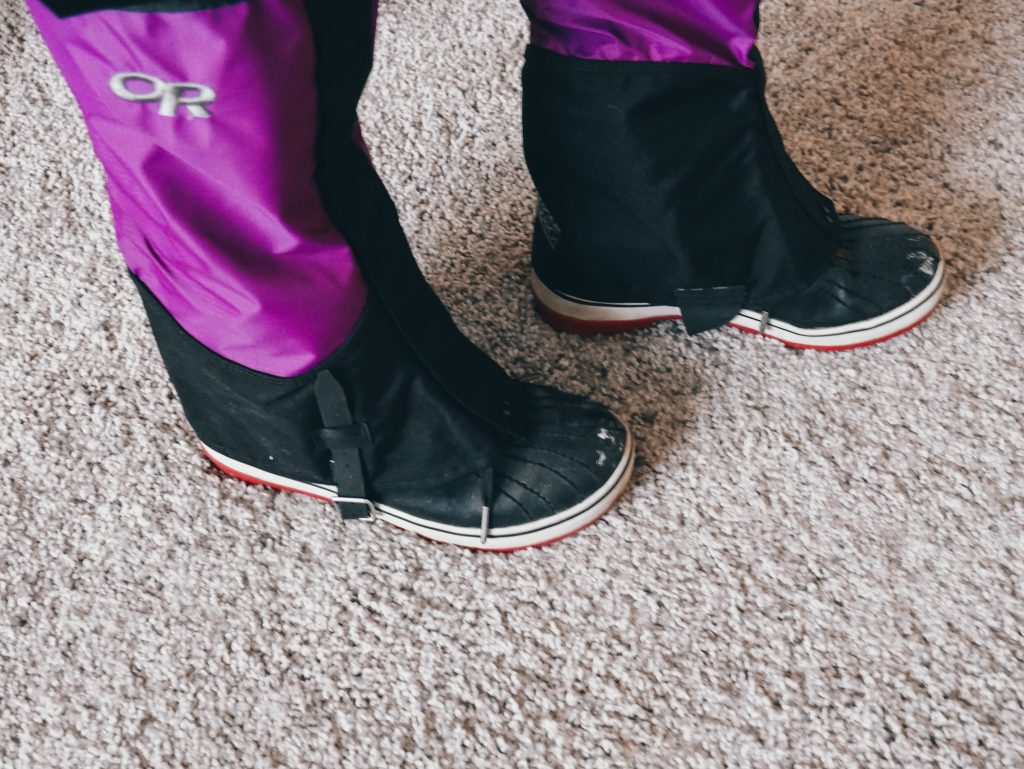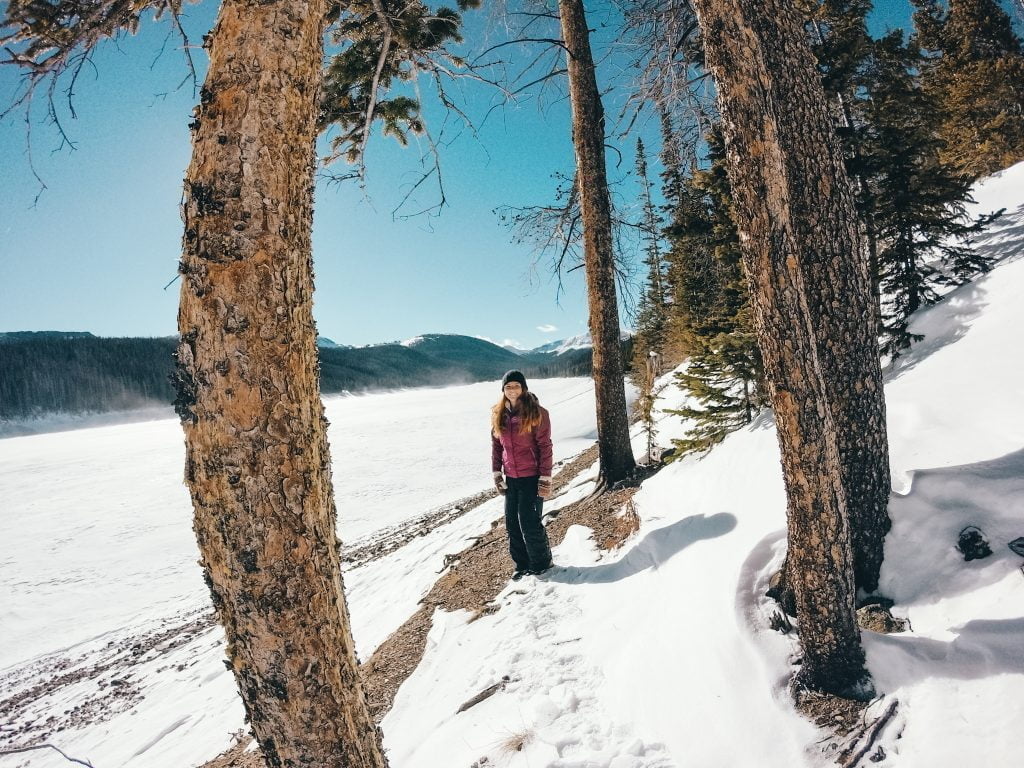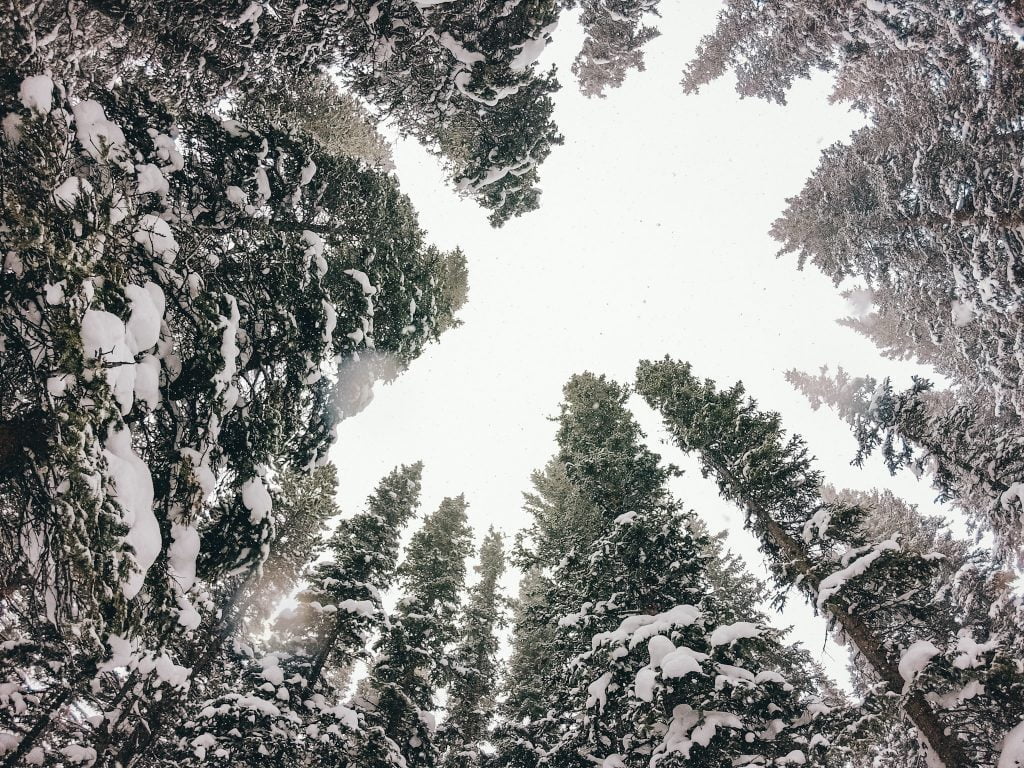Cold weather may be on the way, but that shouldn’t keep you inside. In fact, hiking in the winter can be a great way to stay active while enjoying the lack of crowds and a new perspective on your favorite trails that comes with a fresh blanket of snow. We find it wonderful to be outside in the winter, but it takes a little extra preparation to truly enjoy it. Here’s our winter day hike packing list, which contains everything we bring or wear for a chilly day out in nature.

1. Backpack
This one is pretty obvious, but a sturdy backpack that has enough space to hold all the items you want to bring along, including those extra winter items, is important! Following are a couple things you should keep in mind when looking for a backpack to add to your winter day hike packing list.
- Space: Choose a pack that can hold all of your essentials plus any layers you take off. We usually carry a 40-liter pack for day hikes, but sometimes bring a smaller CamelBak for short excursions.
- Extra Straps: Extra straps or carabiner loops can be helpful if you ever want to attach skis, hiking poles, snowshoes, or other gear to the outside of your pack.
- Water Resistance: Choosing a waterproof pack or a pack with a rainfly can be helpful on snowy days to keep the contents of your bag dry.

2. Gaiters
We usually don’t wear snow pants when going on a day hike, so we really love our gaiters for keeping our lower legs warm and dry when hiking in deeper snow. They also keep snow from getting inside your boots.
Most gaiters can be adjusted at the cuffs to cinch down around your legs, layers, and choice of shoes. Gaiters also come in varying lengths, rising up to anywhere from your lower calves to above your knees. They are light, so they don’t add much weight to your legs. Trudging through snow is already tough enough!

3. Yaktrax, Spikes, or Other Traction Gear
Some trails we frequent in the winter, such as Emerald Lake in Rocky Mountain National Park, consist of packed snow and ice rather than deep snow. In these cases, traction gear is a lifesaver… Seriously, some of these icy trails get steep and super slick in spots.
We use Kahtoola MICROspikes, which consist of chains, spikes, and a rubber piece that fit snuggly to the bottom of your shoes.

4. Waterproof Outer Layer
A waterproof outer layer can keep you dry when snow is coming down and also double as a windbreaker. For the coldest days, we put on our ski jackets, and for warmer winter days, we simply wear a rain jacket over some under layers.
We really love three-in-one jackets that consist of a warm inner layer that can unzip from the outer shell. That way, you have a simple light jacket, a wind breaker/rain jacket, and a heavier jacket all in one.

5. Warm Under Layers
Layers are important when hiking in the winter. As the day warms up and you warm up due to activity, you’ll want to take off some of your layers. The key is not to become overly sweaty because that moisture can make you feel cold.
We typically wear a light, breathable long-sleeved shirt and a light fleece or flannel under our outer jacket(s). Wear and pack extra layers if the weather forecast is showing particularly cold weather.
6. Sunglasses and Sunscreen
While sun protection is important to guard your eyes and skin on any outdoor adventure, we find it to be extra important in the winter. The reflection off the blinding snow can really harm your eyes and skin, so don’t forget use sunscreen and sunglasses to protect your eyes and the skin that isn’t covered by winter clothing.

7. Socks and Extras
Quality socks prevent blisters, pad your feet, and absorb sweat to keep your feet dry and warm. For winter hikes, we always wear Smartwool socks, and they have never failed us. It is always a good idea to bring an extra pair in case your first pair becomes wet.
8. First-Aid Kit
This is something you hope you don’t need, but is always good to have just in case. A basic little kit that has bandages, gauze, ibuprofen, an antihistamine, disinfecting wipes, blister covers, tweezers, tape, and other basic items you may need is good to bring on hikes.
What We Use:
I cannot find the exact kit we have, but it was from REI and is pretty much identical to this linked option. We refill it as needed with our own supplies.
9. Water
During winter hikes, you may tend to feel less thirsty than during a hot summer day. However, it is just as important to keep up on the water to stay hydrated. We either carry a water bladder or a few water bottles, which ensures that we each have a couple liters of water to drink during the hike. The nice thing about winter hikes is that our water stays cold!

10. Navigation Method
It’s always a good idea to plan ahead and know your route. We typically download offline Google Maps to use when we have no service, but we have also used printed trail maps, online maps provided by parks, compasses, and GPS systems.
A map of sorts may be especially helpful in the winter when the trail may be covered under a blanket of snow and may not be clearly visible.
11. Snacks
Trekking through the snow requires extra effort, so snacking periodically can help keep your energy levels up. Even if you don’t plan to eat on the trail, it is always a good idea to carry a little extra food in case you find yourself lost or taking more time to hike than originally planned.
12. Gloves or Mittens & Beanie
A beanie is one of our essentials because it helps trap heat that the body releases. If you become warm while hiking, it is a simple thing to take off and fit in your backpack. We also wear light gloves that are easy to pack. Unlike some winter gloves, the ones we usually opt for for hiking are thinner and not water proof. If you think you’ll be doing some scrambling on your hike or playing in the snow, definitely bring a waterproof pair.

13. Hand and Toe Warmers
Well, this isn’t really an essential for most people. But for those like Lia who get extra cold fingers and toes, these can take away the numb discomfort on those bone-chilling days. They are light and small, making them easy to bring along just in case.

14. Waterproof Boots
The worst thing we think of when it comes to hiking in the winter is wet feet. That’s why we also think that a quality pair of boots is perhaps the most important item on our winter day hike packing list. A good pair of boots will keep your feet dry, support your ankles in icy and uneven conditions, and provide adequate traction and a sturdy sole that can support the use of spikes.
If you don’t hike in deep snow or don’t have waterproof boots, we still recommend applying a waterproofing spray that can help keep the water out and keep the boots in good condition.

Like this Post? Pin it!




